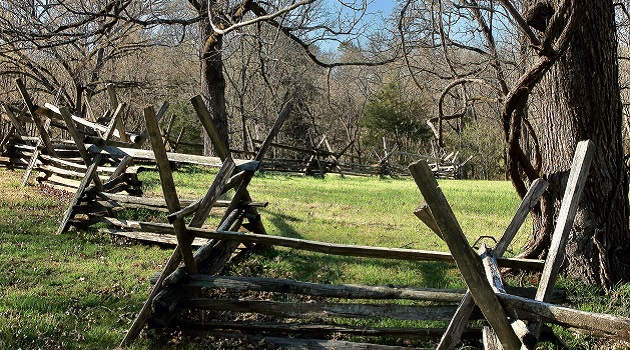The split-rail fence, in harmony with the earth.
By Tom Poland, A Southern Writer
TomPoland.net
A fence has become more than a way to mark property — delineate — as a five-dollar word goes. “I put that fence up to delineate precisely where my line runs.” Redundant. To delineate is to indicate the “exact position.”
Fences have long served as a hoity-toity way to show off. You’ll see a place cordoned off precisely and a lot of times you’ll see the owner has gone to great pains with his fence. Often the owner has put up black fencing such that it resembles a Kentucky board fence, but you’ll see neither horses nor cattle. Near the driveway with its columns of brick and a wrought-iron arch you’ll see a classy sign. It’ll say something like “The Blowhard Estate, Est. 1899.” Well now. Why I bet they even enter a horse in the Derby each year.
On the backroads I pass places with enough white fencing to line the Mexican border. One place has a huge fountain in the middle of its drive, which is lined by many a palmetto tree. Maybe the owner came from Miami. Maybe the owner has an ego.
All this fence business came to me when I came across a split-rail fence. Right away I thought of the pioneers. Their log fence, aka zigzag fence, aka snake-rail fence, looked handsome and natural. I liked it so much I photographed it. I’ve never stopped to photograph one of those “horse-pasture” black fences.
Zigzagging along now … The pioneers knew a practical thing when they saw it. A split-rail fence needs no post holes. It needs few tools. And if they moved, they could take their fence with them and commandeer sections for a particularly brutal winter night.
In my days in the red clay, rocky South, I have manned posthole diggers, and it was not fun. In my days in the humid, sweltering South I have devoted days to removing mildew from Mom’s vinyl fences. Laborious and painful.
Pain is right. In my days of axe-handle baseball a fly ball came soaring at me. I leaped high and fell backwards into a barbed wire fence camouflaged in sweet honeysuckle. My back looked like the American flag … white strips of flesh and rivers of blood. The Indians were right to call barbed wire Devils Rope. It’s hard to think of the Great Plains without remembering cowboys and Indians and range wars and bison. Devil’s Rope changed everything.
Today we see all sorts of fences in all sorts of states. Pristine. Dilapidated and falling. Rotting. Fences crushed by Helene. Privacy fences of every color. Fences of granite. Cyclone (chain-link) fences. Privacy fences. Green steel post fences with their tops trimmed in white. Were it in my power I’d snap my fingers and convert every steel fence to the classic old cedar fence with three strands of Devil’s Rope. You just don’t see cedar post fences much anymore. A pity.
The rare hedgerow fence pleases the senses. They bloom sweetly in the spring and the birds love them. “If there’s a bustle in your hedgerow, now, don’t be alarmed, it’s just the spring queen for the May queen.’ Led Zeppelin’s way of praising the coming of spring. Come fall I sit near a rather famous hedge that “delineates” where the Georgia Bulldogs play home games.
As I said fences tell us a lot. They speak to man’s pragmatic ways, to his possessive ways, to his egotistical ways, and to his tendency to live with disrepair.
A final note on the classic split-rail fence. I see a few here and there. They tell me their owners value history and a rustic way to mark boundaries. They tell me, too, that like so many others they want to show others where their freedom of movement ends. There was a time, you know, when no one owned the land. Fences and homestead laws—two elements of civilization—changed that.


